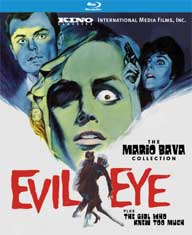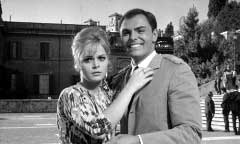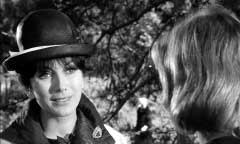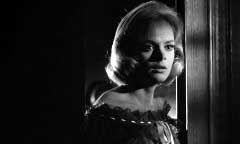 EVIL
EYE/THE GIRL WHO KNEW TOO MUCH (1963) Blu-ray
EVIL
EYE/THE GIRL WHO KNEW TOO MUCH (1963) Blu-rayDirector: Mario Bava
Kino Lorber
 EVIL
EYE/THE GIRL WHO KNEW TOO MUCH (1963) Blu-ray
EVIL
EYE/THE GIRL WHO KNEW TOO MUCH (1963) Blu-rayMario Bava's first feature-length giallo EVIL EYE (aka THE GIRL WHO KNEW TOO MUCH) arrives on Blu-ray including its separate Italian and American versions (both with exclusive footage and different scores) courtesy of Kino Lorber.

Murder mystery-loving American switchboard operator Nora Davis (Letícia Román, G.I. BLUES) arrives in Rome for a month's vacation under the roof of her mother's widowed friend Ethel (Chana Coubert) who is bedridden with a heart ailment and under the care of handsome Dr. Marcello Bassi (John Saxon, TENEBRAE). Already ill-at-ease after having accepted from a charming Italian stranger (Milo Quesada, Frank from "The Telephone" episode of BLACK SABBATH) that a pack of cigarettes on the train turned out to be laced with marijuana, Nora finds her first night in sunny Italy to be a storm-swept gothic nightmare as Ethel dies suddenly. With the phones dead, Nora runs out into the night in search of help and is mugged on the Spanish Steps. Receiving a blow to the head in the struggle, a dazed Nora then witnesses a woman staggering from a house on the steps with a knife in her back. Nora faints again and a passerby tries to revive her with a swig of cognac, which is why the police officer who discovers her next assumes that she is dead drunk. Waking up in the hospital, Nora finds that at best Police Inspector Faccheti (Gustavo De Nardo, BARON BLOOD) thinks that her vivid imagination has gotten away with her, and at worst Dr. Alessi (Robert Buchanan, ESTHER AND THE KING) believes her to be suffering from alcoholism and mythomania (compulsive lying). Marcello vouches for her well-being and courts her while trying to convince her that exhaustion and stress caused her to hallucinate. Reluctant to go back to Ethel's empty house, Nora makes the acquaintance of Laura Craven-Torrani (Valentina Cortese, Truffaut's DAY FOR NIGHT) who invites her to stay at her house on the Spanish Steps while she visits her husband in Switzerland. Starting to believe that she did indeed hallucinate the killing, Nora settles in only to learn from the housekeeper that Laura's sister was brutally stabbed in front of the house ten years before, the third victim in a spree dubbed "The Alphabet Murders" (no apologies to Agatha Christie). While his colleague is willing to entertain the theory that Nora experienced an episode of psychic transference, Marcello remains skeptical until someone lures Nora to an apartment building with the threat that Nora Davis will be the next victim of the alphabet killer.
 Based
on a screenplay by Bava, Ennio De Concini (BLACK SUNDAY), assistant director
Franco Prosperi (LAST HOUSE ON THE BEACH), Enzo Corbucci, Eliana De Sabata,
and Mino Guerrini – whose THE THIRD EYE would mine Bava-esque necrophiliac
themes and would be remade as the considerably more graphic BEYOND THE DARKNESS
by Joe D'Amato – is the Bava equivalent of Dario Argento's DEEP RED (BLOOD
AND BLACK LACE being his SUSPIRIA) in its technical and stylistic advancement
of the giallo genre over his previous "The Telephone" episode of BLACK
SABBATH. Bava photographed the film himself in a monochrome chiaroscuro manner
that is more evocative of his previous gothic work (both in color and black
and white) than in the more obvious film noir stylings while sometimes framing
a terrified Roman in off-kilter close-ups that seem suggestive of her paranoid
perspective as they crop away space in which to sinister background figures
might creep up or a clutching hand might grab her. The film sort of anticipates
Lucio Fulci's giallo THE PSYCHIC in the plot twist where a psychic vision of
something in the past is turned on its head (although to cleverer effect here).
Based
on a screenplay by Bava, Ennio De Concini (BLACK SUNDAY), assistant director
Franco Prosperi (LAST HOUSE ON THE BEACH), Enzo Corbucci, Eliana De Sabata,
and Mino Guerrini – whose THE THIRD EYE would mine Bava-esque necrophiliac
themes and would be remade as the considerably more graphic BEYOND THE DARKNESS
by Joe D'Amato – is the Bava equivalent of Dario Argento's DEEP RED (BLOOD
AND BLACK LACE being his SUSPIRIA) in its technical and stylistic advancement
of the giallo genre over his previous "The Telephone" episode of BLACK
SABBATH. Bava photographed the film himself in a monochrome chiaroscuro manner
that is more evocative of his previous gothic work (both in color and black
and white) than in the more obvious film noir stylings while sometimes framing
a terrified Roman in off-kilter close-ups that seem suggestive of her paranoid
perspective as they crop away space in which to sinister background figures
might creep up or a clutching hand might grab her. The film sort of anticipates
Lucio Fulci's giallo THE PSYCHIC in the plot twist where a psychic vision of
something in the past is turned on its head (although to cleverer effect here).

The comic aspect of the film keeps the romantic subplot from seeming obligatory, as well as rare opportunities for Bava to revel in the "la dolce vita" atmosphere of Rome with scenes set against the Spanish Steps and several other monuments (appropriate since Marcello takes Nora sightseeing) set to a more playful score by early Bava regular Roberto Nicolosi (BLACK SUNDAY) as well as theme song by pop singer Adriano Celentino (THE FIVE DAYS OF MILAN). Bava regulars include BLOOD AND BLACK LACE's Franco Ressell as a customs officer and Dante Di Paolo in a substantial role as a journalist whose career was ruined by his obsessive coverage of the killings. The distinctive façade of the apartment house Nora is lured to is recognizable to Italian horror fans as the philosophy library in Argento's INFERNO as well as Mimsy Farmer's apartment building from THE PERFUME OF A LADY IN BLACK, while production designer Giovanni Giovannini (THE NAME OF THE ROSE) incorporates some set dressings from his sets for "The Telephone" into Laura's house on the Spanish Steps.
 Released
in the United States as EVIL EYE with some AIP-mandated changes shot by Bava
to curb some of the more adult elements – the marijuana-laced cigarettes
became mere contraband cigarettes – and Les Baxter replacing Nicolosi's
score (as he did on BLACK SUNDAY and BLACK SABBATH as well as Stelvio Cipriani's
score for BARON BLOOD), it was one of the few Bava films (and the only Bava
AIP film) to not make it to VHS or laserdisc (or even pay cable-era television)
by way of video-era AIP rights owners Orion or later MGM. Most viewers not old
enough to see the film theatrically would first encounter the film on Image
Entertainment's anamorphic DVD of the Italian version (followed by a slightly-improved
transfer in the first of Anchor Bay's two Bava boxed sets). Those DVD included
an audio commentary by Video Watchdog's Tim Lucas who goes into some detail
about the differences between the Italian and American cuts of the film, but
English-speaking viewers would have to wait for quite some time to actually
see the English version.
Released
in the United States as EVIL EYE with some AIP-mandated changes shot by Bava
to curb some of the more adult elements – the marijuana-laced cigarettes
became mere contraband cigarettes – and Les Baxter replacing Nicolosi's
score (as he did on BLACK SUNDAY and BLACK SABBATH as well as Stelvio Cipriani's
score for BARON BLOOD), it was one of the few Bava films (and the only Bava
AIP film) to not make it to VHS or laserdisc (or even pay cable-era television)
by way of video-era AIP rights owners Orion or later MGM. Most viewers not old
enough to see the film theatrically would first encounter the film on Image
Entertainment's anamorphic DVD of the Italian version (followed by a slightly-improved
transfer in the first of Anchor Bay's two Bava boxed sets). Those DVD included
an audio commentary by Video Watchdog's Tim Lucas who goes into some detail
about the differences between the Italian and American cuts of the film, but
English-speaking viewers would have to wait for quite some time to actually
see the English version.

Arrow Video in the UK released THE GIRL WHO KNEW TOO MUCH on Region B Blu-ray last year. After their releases of BLACK SUNDAY and BLACK SABBATH that included the AIP versions, it was hoped that they would also include the American version EVIL EYE. That seemed unlikely at first because MGM only had a 16mm TV print which – if it looked anything like the bootleg tape and DVDR making the rounds – would have been cropped on all four sides of the frame. Rights owner Alfredo Leone was able to provide a fine grain 35mm print (apparently originated from the UK going by the censor's certificate that opens the presentation) and the American version was included in the set along with the Lucas commentary on the Italian version, trailers for both versions, the Saxon interview carried over from the Anchor Bay DVD, introduction by Alan Jones, and a featurette on the giallo genre.
 With
Kino Lorber's BLACK SUNDAY/BLACK SABBATH double feature of the AIP versions
pulled – but fortunately back on the release slate as individual editions
later this year – it seemed questionable once again if the AIP version
of EVIL EYE would be included on the Region A release. Since Olive Films already
put out a Blu-ray of Francis D. Lyon's 1969 film THE GIRL WHO KNEW TOO MUCH,
Kino Lorber has utilized the EVIL EYE title for their release, top-lining the
AIP version on both the cover and the disc's opening version selection screen.
Transferred from the same masters, Kino Lorber's 1080p24 MPEG-4 AVC encodes
differ in the same manner as those of the UK disc. THE GIRL WHO KNEW TOO MUCH
(85:39) is framed at 1.66:1 and actually seems less sleek than the transfer
of the 1.78:1-framed EVIL EYE (92:15). The LPCM 2.0 mono track on the Italian
version seems a bit cleaner than the uncompressed mono option on the English
version, but both get the job done. The optional English subtitles for the Italian
version differ in minor ways from the Arrow UK translation (although I have
not compared either to the Image or Anchor Bay subtitles).
With
Kino Lorber's BLACK SUNDAY/BLACK SABBATH double feature of the AIP versions
pulled – but fortunately back on the release slate as individual editions
later this year – it seemed questionable once again if the AIP version
of EVIL EYE would be included on the Region A release. Since Olive Films already
put out a Blu-ray of Francis D. Lyon's 1969 film THE GIRL WHO KNEW TOO MUCH,
Kino Lorber has utilized the EVIL EYE title for their release, top-lining the
AIP version on both the cover and the disc's opening version selection screen.
Transferred from the same masters, Kino Lorber's 1080p24 MPEG-4 AVC encodes
differ in the same manner as those of the UK disc. THE GIRL WHO KNEW TOO MUCH
(85:39) is framed at 1.66:1 and actually seems less sleek than the transfer
of the 1.78:1-framed EVIL EYE (92:15). The LPCM 2.0 mono track on the Italian
version seems a bit cleaner than the uncompressed mono option on the English
version, but both get the job done. The optional English subtitles for the Italian
version differ in minor ways from the Arrow UK translation (although I have
not compared either to the Image or Anchor Bay subtitles).

Comparing the two films, one can see that the footage exclusive to the English version were very much a part of the original shooting. The opening plane sequence features a tracking shot that eavesdrops on the thoughts of the passengers leading up to Nora whose thoughts are of murder. A jump cut in the Italian version takes us directly to Nora in the Italian version (on the commentary track, Lucas concedes that the loss of this shot in Bava's original is unfortunate). There is also a scene in which Nora tries to catch a cab only to encounter rude locals (the Italian version cuts directly from the airport to Ethel's front door). A comic sequence features Nora feeling watched by the photograph of Ethel's late husband Augusto (Bava himself), the eyes of which leer at her negligée. After Marcello's neurosurgeon colleague waxes on Nora's apparent mediumistic powers, the American version adds a sequence in which he takes her to visit some ruins by night (seemingly more of an attempt at seduction).
 Although
the tone of the American version is lighter, one of the Italian version's comic
jump scare featuring a tape recorder blaring out the Celentino theme song (deleted
from the opening credits of the American version as well) is snipped out. The
coda sequence is entirely different in the American version, and seemingly trivializes
an act of violence before cutting to an end credits sequence over a sketch of
the Spanish Steps not seen anywhere in the Italian version (the Italian coda
also lacks the match cut from the two bullet holes in the door during the climax
to the close-up of the man with binoculars who plays a role in the American
ending). A male narrator accompanies the Italian version while Nora's own thoughts
are heard in the English version to sometimes stilted effect as they try to
convey some of the same information in a more casual manner. The Italian version
is certainly the superior one, but it is nice to have the AIP version. Besides
the Lucas commentary on the Italian version, the only extras are trailers for
the Italian (2:38) and US (2:10) versions, the latter in extremely poor quality.
(Eric
Cotenas)
Although
the tone of the American version is lighter, one of the Italian version's comic
jump scare featuring a tape recorder blaring out the Celentino theme song (deleted
from the opening credits of the American version as well) is snipped out. The
coda sequence is entirely different in the American version, and seemingly trivializes
an act of violence before cutting to an end credits sequence over a sketch of
the Spanish Steps not seen anywhere in the Italian version (the Italian coda
also lacks the match cut from the two bullet holes in the door during the climax
to the close-up of the man with binoculars who plays a role in the American
ending). A male narrator accompanies the Italian version while Nora's own thoughts
are heard in the English version to sometimes stilted effect as they try to
convey some of the same information in a more casual manner. The Italian version
is certainly the superior one, but it is nice to have the AIP version. Besides
the Lucas commentary on the Italian version, the only extras are trailers for
the Italian (2:38) and US (2:10) versions, the latter in extremely poor quality.
(Eric
Cotenas)